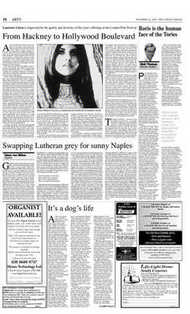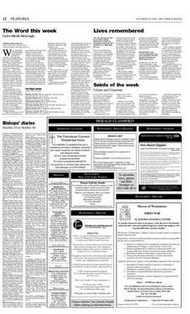Page 6, 22nd October 2004
Page 6

Report an error
Noticed an error on this page?If you've noticed an error in this article please click here to report it.
Tags
Share
Related articles
New Editor
New Editor For 'catholic Herald'
Catholic Scion Challenges Blair
Catholic Herald
Memorial Service Honours Life Of Premier Catholic Peer
Meat And Miniskirts
Oddballs and adventurers
Gerard Noel, editorial director of The Catholic Herald, has delved into his family history to write about his ancestor Sir Gerard Noel MP. Richard Compton Miller unravels the tale of an extraordinary political dynasty Chipping Campden is one of the loveliest small towns in the Cotswolds, with its ancient golden stone buildings gently curving down the high street.
Visitors flock there throughout the year, admiring the Jacobean market hall with its cobbled floor and magnificent oak timbers, 17th-century almshouses and the 15thcentury parish church. But even the dumbest tourist will spot a recurring theme in this prosperous Middle England bastion that was originally built on the medieval wool trade. The name “Noel”‚ and the family titles “Gainsborough” (Earl of) and “Campden” (Viscount) constantly crop up in street names, church memorials, gravestones, hotels, hostelries and even on a Regency street pump.
As you enter the Town Hall off the high street you cannot fail to notice the large portrait, by Sir Thomas Lawrence, of a cerebral, silver-haired gentleman wearing red, ermine-fringed robes.
The sitter is Sir Gerard Noel, high steward of Chipping Campden and Rutland’s MP for nearly half a century, whose colourful life was of such importance to the town and Noel family. He is the subject of a new biography by his great-great-great grandson, Gerry Noel, published this week, which also covers the family’s ancestry from the Norman Conquest.
Gerry, the younger brother of the Earl of Gainsborough and a former editor of The Catholic Herald, has lived in Chipping Campden, Gloucestershire, for over 30 years and is president of the Campden Society.
Parts of his home, Westington Mill, are said to date from the Domesday Book. “The town was once just one of the family estates scattered between Staffordshire, Rutland, Hampshire and Hampstead,” he explains. “The Noels seem to have had two prominent characteristics: our ability to squander money and the early deaths of the Gainsborough heirs. The result has been that the earldom has frequently been inherited by a minor and even, on two occasions, by a cousin minor.” Sir Gerard, who married three times and had 19 children, is not an heroic figure in Gerry’s eyes. “He was born worth a million pounds, which in today’s money would be about £200 million, but died completely broke in 1838”, he says. “This was not only due to his extravagance but to bad business ventures and his espousal of lost causes, including several court cases. When asked why his tailcoat only had one tail he is said to have replied: ‘After being involved in so much litigation I can only afford one’.” In 1841 Sir Gerard’s eldest son Charles fulfilled his father’s dearest ambition. The new prime minister Robert Peel created him Earl of Gainsborough for his support in the House of Lords over the repeal of the Corn Laws. He thereby revived the family title that Charles II had originally given the Noels in 1662 for fighting for the royalists against Oliver Cromwell.
The earldom had become extinct in 1798 when the unmarried sixth Earl died without leaving any heirs. His lands, however, had gone to his nephew Gerard Edwards who thereupon assumed the surname and arms of Noel by royal licence. His blackened portrait is the one that hangs in the town hall.
The Noels have been landowners, politicians and philanthropists for many generations. Their position as one of Britain’s leading Catholic families only came later, with the conversion in 1850 of the 2nd Earl (under the new creation). He was married to William IV’s grand-daughter Lady Ida Hay.
Gerry himself has been married to a Devon major’s daughter Adele Were for nearly 50 years and has three children.
“My wife’s mother, Dr Josephine Were, was one of the first women to qualify as a doctor in Ireland,” he recalls. “During the last war she did magnificent work caring for the victims of the London Blitz and was awarded the OBE.” Gerry’s researches reveal that the Noels have also sired “an unconventional array of adventurers and oddballs”.
There was Gerard’s greatgrand-daughter Lady Blanche Murphy, who was Queen Victoria’s goddaughter. In 1872 she surprised her family by eloping to New England with her father’s organist and, with only 15 dollars to her name, began a new life there as a writer.
Gerry recalls meeting in his youth Gerard’s heroic great-greatgrandson John Noel. “He lived to nearly a hundred and was exceedingly charming and extremely modest about his achievements.
“While a subaltern attached to the Indian Army he disguised himself as a Muslim in 1913 and explored the dangerous passes leading to Mount Everest, which was then virtually unknown. As well as being a mountaineer he became an intrepid photographer who accompanied one of the first British expeditions to Everest.” Another Empire-building relation was Edward Noel, a great-great-grandson of Sir Gerard, who won the MacGregor Medal for bravery. “He was a gifted linguist who became an explorer in the Middle East and Asia, often adopting disguises and living rough,” recalls Gerry. “It was said that John Buchan modelled the hero of his novel Greenmantle‚ Sandy Arbuthnot, on him.” For a dynasty that has such deep roots in Chipping Campden it is perhaps surprising that there is no family seat there.
Thanks to their ancestor Baptist Hicks they did briefly own Campden House, a swanky mansion that he built at great cost in 1610. It was dubbed the Jacobean jewel of the Cotswolds.
Hicks was a nouveau riche City silk merchant who became a baronet and later the first Viscount Campden.
In 1605 his eldest daughter Juliana had married a local army officer, Edward Noel, who had fought in the Irish wars.
As Hicks had no male heirs his estate passed to his son-in-law on his death in 1629, plus, unusually, his titles by special letters patent.
During the Civil War Campden House burnt down. The royalist Noels were said to have ordered its destruction as a scorched earth policy to prevent it and the town being pillaged by the advancing Commonwealth troops.
Visitors to Chipping Campden can still see the stylish remains of the Noels’ former stately home close to the 17th-century home of Gerry’s sister Lady Maureen Fellowes, stepmother of Oscar-winning author Julian Fellowes.
Two brick banqueting houses with ornately twisted chimneys face each other across a garden at right angles to what would have been the main house.
The Landmark Trust restored them and rents them out. Indeed, the author Salman Rushdie is said to have taken refuge in one shortly after Iran’s Ayatol lahs issued their fatwa against him for his 1988 novel, The Satanic Verses.
The first Earl rebuilt Campden House on a new site in high Victorian style in 1850. But in 1928 they sold it “in a panic when they thought they were going broke,” says Gerry. The present owner, Philip Smith, is a WH Smith heir.
It still rankles that the Noels’ Chipping Campden estate was sold off piecemeal during the Twenties. Mismanaged for generations it never recovered from the double estate duties levied after the death of the 3rd Earl in 1926 and the 4th earl, Gerry’s father, the following year.
“In the immediate aftermath of the Great War many of the larger houses in Campden were modernised, mainly at the landlord’s expense, in the hope that financial rewards would soon be reaped by such improvements,” he explains. “However, the rewards did not come soon enough, and there followed a disastrous loss of nerve, resulting in the wholesale disposal of Noel property.” The situation, Gerry adds, was a clear reflection of Lady Bracknell’s comment that “land gives one a position, but prevents one from keeping it up”. Had the family been better advised and borrowed from the bank, the estate could probably have been saved, as property values rose in Chipping Campden shortly afterwards.
Luckily the Noels still retain their other family seat, Exton in Rutland, which is now occupied by Lord Gainsborough’s heir Viscount Campden and his wife Sarah, a former Ladyin-Waiting to Diana, Princess of Wales.
Today, in common with the Cecils, the Noels continue to prosper, not only in public life but in more recherché fields. Lady Juliana Noel lent her name to the society disco, Lady Celestria Noel wrote the social column “Jennifer’s Diary” in Harper’s & Queen and the author’s son Robert is Lancaster Herald at the Royal College of Arms.
Next month Gerry, who has written biographies of Pope Paul VI, Cardinal Basil Hume and Queen Victoria’s grand-daughter Princess Ena, publishes a biography of the late Duke of Norfolk, Miles Fitzalan-Howard.
Sir Gerard Noel MP and The Noels of Chipping Campden and Exton by Gerard Noel is published by the Vale Press on October 22, priced £17.95.
An extract from Gerard
blog comments powered by Disqus















